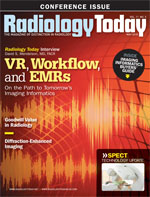May 2010

PACS and RIS — User References Are the Key
to Successful Integration
By Jim Knaub
Radiology Today
Vol. 11 No. 5 P. 6
“We are looking for a new PACS and RIS…”
You frequently see online discussion threads begin this way—and many discussions at meetings start with a similar statement. Whether a facility is implementing its first PACS and RIS or replacing an existing system, considering them together improves an organization’s chances of being satisfied with the system it ultimately puts in place. From a systems perspective, it has always been smart to consider PACS and RIS together, but it is increasingly important in a medical IT world that is pursuing tighter integration and interoperability.
I recently read a post seeking advice on choosing an RIS that would work well with the PACS a particular hospital had selected. To some extent, it makes sense for PACS issues to drive decisions because it is the system that radiologists use to interpret exams and distribute images on which other physicians base their treatment. But medical organizations are businesses, too. PACS and RIS need to work together to make that business run efficiently.
In that light, here are a few tips—including the big one—for helping ensure that these two key tools truly serve your organization: Does the PACS vendor you’ve selected (or are considering) also offer an RIS? Purchasing both from the same vendor will ease integration issues and simplify support, providing the RIS that meets your needs. When they’re the same vendor, the RIS company and the PACS company can’t point their finger at the other and blame them for your problems. While one vendor offers advantages, you must make sure the RIS you select will meet your facility’s needs.
While those are advantages to having one company provide both your RIS and PACS, a system that works but doesn’t do the things you need it to do is a false bargain and the reason many facilities select the so-called best-of-breed option when purchasing systems and equipment.
If the PACS vendor you select does not offer an RIS, or it does not meet your needs, one screening tool in your search is to find out whether the RIS vendors you are considering have successful integrations with the PACS you are purchasing or considering. A track record of successful PACS integration is a good sign. Another increasingly relevant RIS-related issue is where your facility is in terms of implementing an EMR. Your RIS would certainly interface with any EMR; the ability to handle that interface would be important.
How to Check References
But the single most important step in evaluating providers is obtaining thorough customer references. Get references from those sites with successful installations. Specifically, ask the vendor for a list of 12 to 20 sites and then contact several of them randomly, ideally including several facilities similar to yours. You’re much more likely to get an unbiased report from an interview that you pursue and arrange than one set up by a vendor.
On his blog at Risology.com, Swearingen Software founder and CEO Randall Swearingen calls checking referrals “probably the most important due-diligence activity that you will ever perform during the RIS selection process.” He notes that you are investing significant time and money in an RIS, and speaking with a range of customers is the best way to find out the truth about a system.
“It just makes good business sense to talk to their existing customers because referrals are the absolute best way to get the skinny on vendors and their products,” Swearingen wrote. “nfortunately, when you ask an RIS vendor for a list of referrals, what do you get? Most vendors will give you a very short list of less than five referrals. Guess what? Those referrals will NEVER tell you something bad about the product or the company because those are the vendor’s ‘A’ list with whom they have some type of referral agreement…”
Swearingen also recommends speaking to at least two people from each reference facility.
While there are numerous technical and other considerations involved in selecting an RIS, the most important one is finding good field intelligence on how these systems work in the real world.
— Jim Knaub is editor of Radiology Today.

